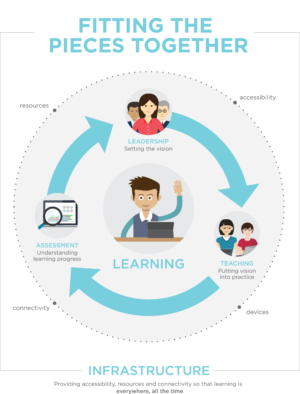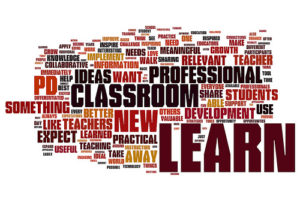
In the Educational Leadership journal of February 2009, Jason Margolis writes about strategies that teacher leaders can embed to engage their colleagues and realize the benefits of instructional changes. While there were a number of presentations reviewed, the strategies below produced “observable teacher engagement”. The one constant in these researches is that teachers value the knowledge, innovation and leadership of their peers.
The one strategy that I had not seen in my other readings was to use humor. By creating a relaxing environment and removing the tension, teacher leaders were successful when they introduce serious topics. Teacher leaders also have an impact since they understand the culture, as well as the needs of the teachers. In addition, can bring that needed element of respect. Presenters find that if they explain where they found challenges and how they worked through a solution, allowing them to be learners too. Sharing student work demonstrates what is possible, allowing teachers to recognize achievement.
Professional development is best when centered on the needs of teachers and affect student learning. Provide examples that are relevant to all teachers, no matter what content area they teach, relevance brings meaning and buy in from everyone. Having the opportunity to use content from their disciplines, collaborate with others and apply the learning to current work creates practical uses that affect student learning. Especially as teachers have a chance to work with the strategies and observe how other teachers use the opportunities. They should be adaptable and easy to use strategies, those that they can use data to measure student growth. The ability to practice and reflect provide an opportunity for teachers to use their experiences and knowledge.
Th ere were four ineffective approaches described; lecture was at the top of the list. Not surprisingly, the longer the lectures, the more learners lose attention. Ending with an open ending “Are there any questions?” few are listening and silence is common. Overloading professional development is another problem. There is a limited amount of time, and there are countless strategies. I remember as a teacher trying to juggle four different initiatives with artifacts due and teach, it is frustrating and everything suffers. Lastly, not providing a variety of examples and demonstrations. If it is all about the individual presenter’s experiences, the ability to understand how it fits in your own classroom diminishes.
ere were four ineffective approaches described; lecture was at the top of the list. Not surprisingly, the longer the lectures, the more learners lose attention. Ending with an open ending “Are there any questions?” few are listening and silence is common. Overloading professional development is another problem. There is a limited amount of time, and there are countless strategies. I remember as a teacher trying to juggle four different initiatives with artifacts due and teach, it is frustrating and everything suffers. Lastly, not providing a variety of examples and demonstrations. If it is all about the individual presenter’s experiences, the ability to understand how it fits in your own classroom diminishes.
Increasing teacher and student digital and media literacy starts by embedding technology to improve student-learning activities. Devices have increased in schools in Washington State, however, recently emphasizing learning how to help teachers integrate technology into content. The integration is not about how to use the tools; it is knowledge of the strategies needed for learning. Technology should transform and expand student learning, to do so it should be an integral part of teacher professional development. There needs to be freer and openly licensed educational content, an example is on LearningRegistry.org. To fully implement technology, integration needs to be part of our education system for pre-service teachers and in-service professional development.
Knowing how to use the strengths of adult learners is key, but just as importantly, understands how to curb the strong opinions and habits that impede the process. Even today, there are teachers that are intimidated by technology; some find the options to be confusing. For these teachers having access to hands on practice that is timely and relevant are key.
References:
Bishop, D, Lumpe, A., Henrikson, R, & Crane, C. (2016). Transforming Professional Learning in Washington State – Project Evaluation Report. Seattle Pacific University: Seattle, WA. http://www.k12.wa.us/CurriculumInstruct/WA-TPL/pubdocs/2016-WA-TPL-Evaluation-Report.pdf
Bransford, J.D., Brown, A.L., and Cocking, R.R. (2000). How People Learn: Brain, Mind, Experience, and School. http://www.nap.edu/catalog.php?record_id=9853 Washington, DC: National Academy Press.
Knowles, M. (n.d.). ACU (Australian Catholic University). Retrieved January 27, 2017, from http://www.acu.edu.au/staff/our_university/faculties/faculty_of_health_sciences/professional_practice_resources_for_supervisors/interprofessional_resource_library/Facilitating_Learning/knowles_principles
Learning Registry. (n.d.). Retrieved January 27, 2017, from http://learningregistry.org/about/
Margolis, J. (2009). How teachers lead teachers. Educational Leadership. Volume 66, No. 5 February Retrieved from http://www.ascd.org/publications/educational-leadership/feb09/vol66/num05/How-Teachers-Lead-Teachers.aspx
Thoms, K. J. (2001). They’re Not Just Big Kids: Motivating Adult Learners.
U.S. Department of Education, Office of Educational Technology. (2016). Future Ready Learning Reimagining the Role of Technology in Education 2016 https://tech.ed.gov/files/2015/12/NETP16.pdf
Shannon, I enjoyed reading your post. You hit on a number of key techniques to keep in mind, the use of: some humor to create a comfortable environment for learning, a variety of examples to provide a clearer picture, hands-on opportunities to really have time to put the learning into action.